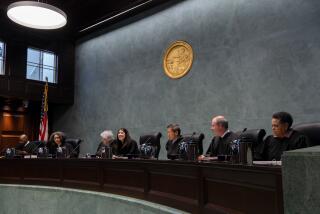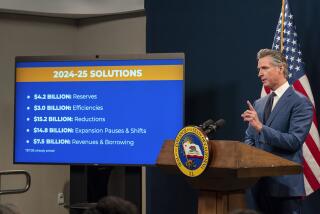This Solution Would Be Taxing for Only 1% of Californians
Californiaâs business and political leaders are never at a loss for new ways to soak the poor and the middle class.
Is there a budget crisis? Letâs cut back on state health programs and public assistance, jack up camping fees at the state parks, cut back enrollment at the colleges and universities while raising tuition and toss another quarter-percent onto the sales tax. Oh, and letâs borrow $15 billion to cover last yearâs budget deficit, so we can continue to soak the same people for another decade.
Isnât it time to soak the rich?
âSoakâ perhaps isnât the mot juste. The proposal most frequently heard in Sacramento is to restore the 10% and 11% tax brackets that were dropped from the state tax code in 1995, when 9.3% was set as the top rate. The change would produce $2 billion to $3 billion a year in additional revenue, which plainly would do much to cut into the stateâs apparently permanent annual deficit of $7 billion.
(This is not the only proposal out there. Professors John Bachar of Cal State Long Beach and Paul OâLague of UCLA have proposed a temporary surcharge of up to 7% on the wealthy, which they say would raise more than $13 billion a year. That would place the state budget on a gratifyingly firm footing, though at the risk of scaring some potentates into seeing socialists under their beds.)
Restoring the top brackets would cost the wealthiest 1% of all state residents -- those reporting family incomes of $560,000 or more -- an average of $9,700 a year, according to a study by the nonpartisan California Budget Project. As my colleague Steve Lopez has argued, since members of this group pull down an average annual income of $1.6 million, itâs hard to imagine that any of them will have to pawn a yacht or remortgage the house in order to make his or her new nut.
Thatâs especially true in light of the effect of the recent federal tax cuts. Thanks to President Bush, the same top 1% of California residents will enjoy a total of about $12.75 billion in tax savings in 2003. (The figure comes from Citizens for Tax Justice, a Washington tax reform organization.) That works out to nearly $68,000 each in federal tax savings -- more than enough to cover their higher state tax.
The idea of raising the tax rate on people in the top brackets is certainly not new. Nor is it, by definition, a Democratic policy, or a liberal one, or a wasteful one. The last California governor to raise the top rate to 11% was the Republican Pete Wilson, who took the action in 1991 to help close a $14-billion hole in his $40-billion budget, but whose advisory portfolio with the Schwarzenegger administration evidently doesnât include issues of fiscal responsibility. Before Wilson, the previous governor to raise the top rates was Ronald Reagan -- also, I believe, a conservative Republican.
None of this has kept the California anti-tax lobby from libeling the proposal as a âjob-killer.â One of the more imaginative screeds came from the California Taxpayers Assn., or Cal-Tax, a front for big business. Cal-Tax argued that because 80% of the stateâs businesses meet their state obligations via the personal income tax rather than the corporate tax, a raise would hurt âsmall, profitable businesses.â The state should âfoster and encourageâ these sainted enterprises, the group said in one of its anti-tax fliers, not âhammer these businesses with new taxesâ and drive them to âsome other state.â (The handout also suggested that baseball star Alex Rodriguez had moved from the Seattle Mariners to the Texas Rangers rather than California because Texas had no income tax. Presumably the organization will issue an updated version, now that A-Rod has abandoned tax-free Texas for tax-heavy New York.)
Cal-Tax wants people to believe that a rise in the top rates thus would spell doom for a lot of little entrepreneurial mom-and-pop operations. The truth is, of course, that any small business hit with the new top rate would be a sole proprietorship racking up profit of more than $580,000 a year, which doesnât sound like a business on the edge of extinction.
Anti-tax activists have long complained that Californiaâs income tax is overly âprogressive,â meaning that the rate curve rises sharply with each higher bracket. Restoring the 10% and 11% brackets will naturally make it even more progressive.
But the appropriate level of progressivity, like the appropriate tax rate, is always subject to debate. During the Kennedy administration, the top federal tax rate was 91%, applying to incomes of $200,000 a year or more; JFK nevertheless feared that voters would consider a tax cut fiscally irresponsible.
Moreover, the personal income tax doesnât tell the whole story. Taking into consideration their share of sales and property taxes, Californiaâs wealthiest residents pay a smaller percentage of their total income in taxes (once the federal deduction for state taxes is factored in) than taxpayers in any other bracket. Those who earned $567,000 or more in 2000 paid a net 7.2% of their income in state and local taxes; those who earned less than $18,000 paid 11.3%.
One way that tax opponents justify this disparity is by arguing that the rich burden public services less than the poor. This is true only if you define public services narrowly -- public schools, public assistance, Medi-Cal, etc.
But isnât that too narrow? The wealthy occupy a disproportionate ratio of our coastal property, forcing other Californians to seek recreation by cramming themselves into the scant remaining public beachfront. Their typically larger vehicles cause proportionately more air pollution, their gardens and golf courses consume more water, their personal concerns preoccupy more of the governorâs attention span. (Are these stereotypes? Certainly, but no more egregious than those the establishment uses to demonize the poor and immigrants as being mostly welfare cheats and Medi-Cal frauds.)
Meanwhile, the wealthy enjoy a disproportionate share of tax breaks, legal and otherwise. Take the issue of abusive tax shelters. It should go without saying that these are not investments normally marketed to welfare recipients, yet they never get mentioned in the boilerplate of political speeches devoted to ferreting out âwaste, fraud and abuse.â They probably cost the state government lots more than any Medi-Cal scam, however. State tax authorities estimate that fraudulent tax shelters cost the state as much as $1 billion a year; other estimates go as high as $1.3 billion.
Then thereâs the mortgage interest deduction, which currently applies to interest on mortgages up to $1 million, and on first and second homes. Elizabeth Hill, the state legislative analyst, calculates that reducing the mortgage ceiling to $600,000 and limiting the deduction to primary residences would generate more than $1.1 billion in revenue over the next two budget years -- obviously without producing widespread hardship, even in this stateâs febrile housing market.
Those in favor of asking more from our top earners argue that thereâs no other way to continue making the kind of public investments that built this state over the last half-century. âPeople are forgetting that public investments are at the center of private successes,â State Treasurer Phil Angelides, who has been plumping for the increase, told me last week.
Angelides dismisses the âjob-killerâ talk by noting that any sensible businessman would prefer having a balanced fiscal structure in Sacramento over the disingenuous pandering that prevails today, with politicians falling all over one another to reassure voters that thereâs no need to actually pay full price for all the state programs they insist on.
He also ridicules the notion that the 10% and 11% rates are inconsistent with economic growth. âYou canât tell me that the existence of these rates from 1973 on killed our economy,â he says. âThey didnât stop the stateâs growth -- Silicon Valley flourished in that era, and the stateâs growth outpaced the nation.â
One feature of state government then was that it was stingy with debt and unafraid to levy sufficient taxes to fund current expenses. The logic of that policy has been buried by anti-tax P.R.
Typical of todayâs loony approach to the state budget is how Gov. Arnold Schwarzeneggerâs TV commercial for his $15-billion budget bond (thatâs the ad that shows the Republican governor and Steve Westly, the Democratic state controller, cooing at each other like a pre-breakup J. Lo and Ben) carefully skates over an ugly little fact: Even if the bond passes, the state will still face a $7-billion deficit by mid-2005.
Schwarzeneggerâs assertion that the state would suffer âArmageddonâ if the bond measure fails is cynical in the extreme, because it assumes that California has only two fiscal choices: borrow up to its neck, or fall into the sea. Ruling any other solution out of order is an old political ploy, but why should 99% of the stateâs taxpayers go along?
Golden State appears every Monday and Thursday. You can reach Michael Hiltzik at [email protected] and read his previous columns at latimes.com/hiltzik.
More to Read
Get the L.A. Times Politics newsletter
Deeply reported insights into legislation, politics and policy from Sacramento, Washington and beyond. In your inbox three times per week.
You may occasionally receive promotional content from the Los Angeles Times.











